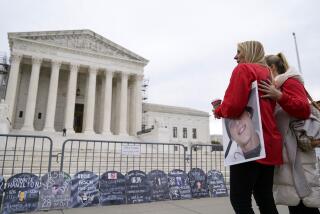Court Says Pioneer Can Use $1.5 Million in Investor Funds
SAN DIEGO — U.S. Bankruptcy Court Judge James W. Meyers on Tuesday authorized financially strapped Pioneer Mortgage to use $1.5 million in investor funds to pay operating expenses and create a pool that will help reimburse investors who lost money when the La Mesa-based mortgage broker collapsed in early January.
Under the complex plan, about 200 investors will be given 75% of the $7 million in net proceeds of 14 real estate loans that soon will be paid in full by borrowers. However, in order to receive payment, those investors must agree to turn over about $1.5 million to Pioneer.
Meyers said the cash is needed if Pioneer President Dennis Schmucker is to begin the tough job of restoring the value of Pioneer’s troubled $250-million loan portfolio.
“That’s what this case is all about . . . building as big a pie as possible . . . and distributing it,” Meyers said.
But the distribution of proceeds from the 14 loans drew stiff opposition from the Office of the U.S. Trustee, the court-approved examiner and several attorneys who represent different groups of Pioneer investors.
Larry Ramey, a senior attorney with the U.S. trustee, said the distribution could be used as a “precedent” to justify further distributions that might harm some investors who hold weaker loans.
The agreement that Meyers approved was the product of lengthy negotiations between the court-approved Pioneer creditors committee and the company’s existing management.
“I personally view (Meyers’ decision) as a major advancement in this bankruptcy case,” said Ali Mojdehi, an attorney who represents the creditors committee. “In the long run, it will be viewed as an event that’s really going to let this estate enhance the return to creditors.”
The distribution that was agreed on Tuesday was necessary because bankruptcy law mandates that Pioneer management use only “free funds” that are not obligated to creditors or other parties to fund operations, said Don McGrath, who also represents the creditors committee. The $1.5 million qualifies as “free funds” because it would be voluntarily turned over to the company by investors, McGrath said.
Schmucker said the distribution and holding back of $1.5 million cash are “the only way” to give the company immediate access to funds needed to finance the “mammoth task” of safeguarding Pioneer’s loan portfolio.
Eventually, Schmucker said, the bulk of the money held back will end up being used to reimburse investors who have lost money through their Pioneer investments.
But Ramey argued that the dispersal sets a precedent that could haunt investors as the complex case moves through bankruptcy court.
Ramey said Pioneer will try to use the narrow distribution as a “precedent” when the court eventually settles the much-broader question of who--the company or individual investors--owns the vast majority of loans in Pioneer’s $250-million portfolio. That question is important because it will determine whether loans are returned to individuals or pooled for eventual prorated distribution to all Pioneer investors.
Investors with solid loans might benefit from the distribution of funds as loans are paid off during coming months, Ramey said. But the distributions might be unfair to investors with non-performing loans, many of whom want Pioneer to pool good and bad loans together, Ramey said.
During Tuesday’s lengthy court hearing, Meyers also rebuffed an attempt to terminate J. Cole Francis, the court-approved examiner who in March linked Pioneer’s financial woes to bad management decisions and possible fraud by Gary Naiman, the company’s principal owner and former president.
Meyers directed Francis to prepare a report on the legal and financial strategies that Pioneer’s current managers should be studying as the company moves toward a reorganization.
More to Read
Inside the business of entertainment
The Wide Shot brings you news, analysis and insights on everything from streaming wars to production — and what it all means for the future.
You may occasionally receive promotional content from the Los Angeles Times.










